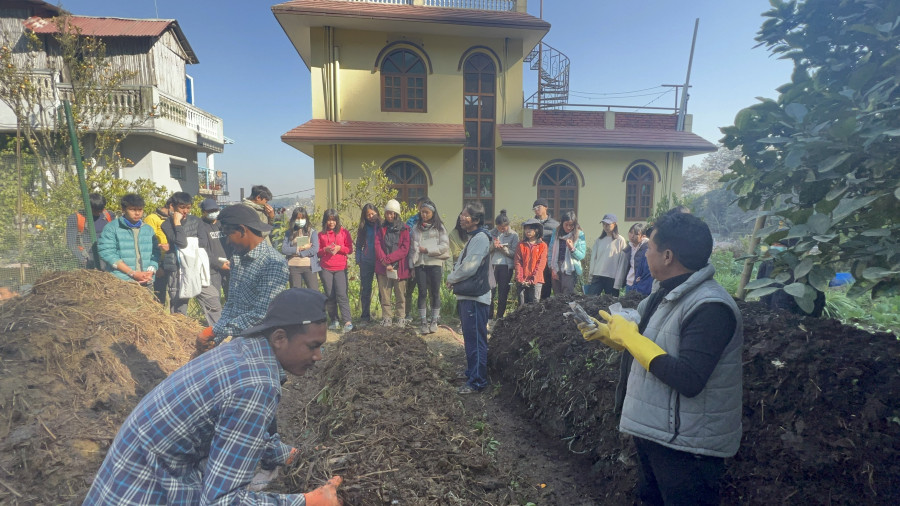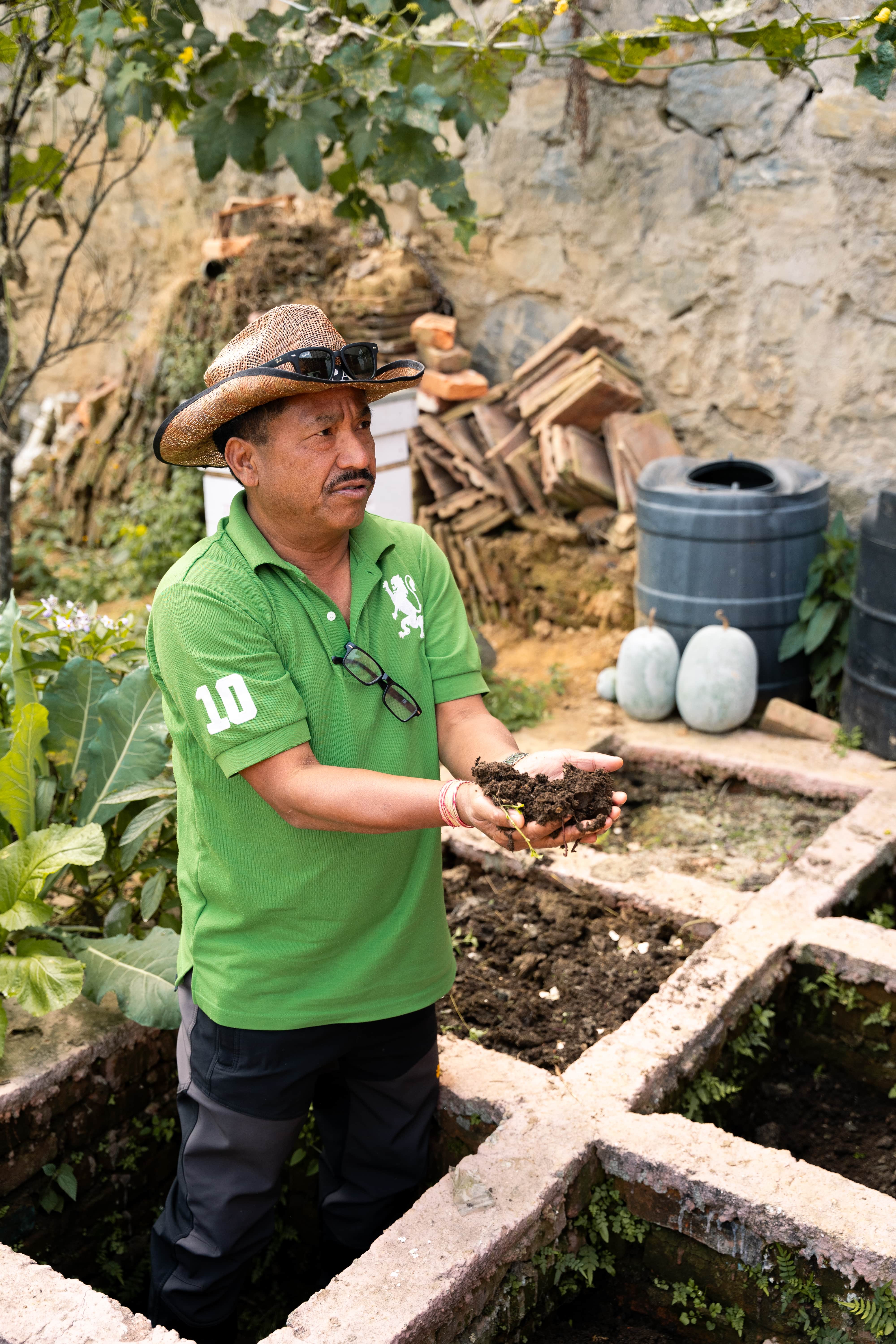Culture & Lifestyle
Farming for the community
A foundation on the outskirts of Kathmandu is making life better for a community using a holistic approach and multifaceted projects.
Ayse Turcan
Standing on the roof terrace of the main house of the Kevin Rohan Memorial Eco Foundation (KRMEF) feels like one is standing at the interface between tradition and modernity. To the west is the lush greenery of the garden, broad hills covered with trees and high up the mountain Champa Devi. On the other side, one gets a clear look over the Kathmandu Valley. The residential and high-rise buildings in the distance fade into the constant haze and traffic smog. Yet, the standout feature is what Krishna Gurung, along with his wife and others, has built over the past decade: a sustainable and organic oasis where everything appears well-planned and functional.
“This is the school,” says Gurung and points in the direction of a tall building before showing all the other achievements of his foundation from above: a medical station where people get free treatments, a construction that houses an eco café and a jewellery workshop, houses for guests, for local families, a little stable as well as different patches and small fields where various vegetables grow.
It all started with a tragic stroke of fate. After the death of their son Kevin Rohan due to an accident in 2008, couple Krishna and Leela Gurung decided they wanted to do something meaningful to commemorate his life and help impoverished communities. being abroad for a while, they came back to Nepal in 2010 and decided to live in Krishna’s father’s house in Kahare, a community southwest of Kathmandu “When we got back to Nepal, our idea was to help children with education, to purify the soil and treat patients with medicine. We also wanted to include the whole community in the project,” recalls Krishna.
After opening a medical station and supporting a few local families, he soon began working on the land—first on his father’s property, then on additional nearby soil that he and his wife either bought or rented. His interest in agriculture stems from his fascination with anthroposophy. He got into this spiritual philosophy while studying physiotherapy in India. Various aspects of the teachings of anthroposophy are controversial, including some of the methods used in agriculture, the set of it called biodynamic farming. Independent scientists assume that there is no proof of efficacy for some of the practices, like the use of so-called biodynamic preparations, but also stress that soil quality tends to be better on biodynamically farmed land, likely due to composting.

But what does biodynamic agriculture actually mean? While organic farming can take various forms and generally refers to agricultural methods that use fewer pesticides and natural fertilisers, derived largely from animal and plant wastes, biodynamic agriculture is always organic but goes a few steps further. “To purify soil that has been used for conventional agriculture, it takes three years to reach organic standards and five years to become biodynamic,” explains Krishna. The biodynamic approach calls for holistic nutrient cycles, meaning that compost and fertiliser should, whenever possible, be produced on the farm and with the involvement of the farm’s animals.
He shows how this looks in practice while walking among the mango, orange and avocado trees in the garden. “Right now, we have broccoli, cauliflower, radish and coriander growing,” Krishna notes, pointing to different patches. He then pauses in front of a structure used for producing natural fertiliser. “Take a look,” he says, allowing a handful of dark humus soil to trickle through his fingers. In this pit made of local clay, Krishna and his co-workers mix the dung from their cow with the dust of egg shells from their chicken and rock dust that contains silica.
Krishna explains that the resulting substance is a potent solution for soil and plants, stating, “Knowing how to create effective organic compost is a blend of ancient wisdom and modern science.” To him, this forms the essence of biodynamic farming. The cow pat pit is just one example of the circular economy on the premises of KRMEF. There is also a large compost area and a small facility for biogas production. Looking at the flourishing plants and smelling the fragrant soil, it seems like this cycle of organic food production is indeed successful.
“I believe agriculture is one of the most important topics in Nepal,” says Krishna, expressing his worry about the widespread use of chemical manure and pesticides in conventional large-scale agriculture. The excessive use of these chemicals is linked to adverse effects on soil quality, water sources, and animals, and is energy-intensive in production. Nonetheless, using chemicals is easy and promises better yields in the short term. “Some of the poor farmers are aware of this and rely solely on chemical fertilisers,” reveals Krishna. This concern drives his regular travels to rural areas in Nepal, where he educates farmers about the advantages of organic and biodynamic agriculture. Just two days ago, he returned from Chitwan, where he taught farmers how to make compost. He emphasises that even if people don't believe in or can’t afford biodynamic preparations, the most crucial thing is to avoid using chemicals.

The idea that organic farming would benefit Nepal’s agricultural sector is not new. Some government officials have stressed the importance of promoting organic farming methods since the early 2000s. However, less than one percent of the agricultural land is certified organic. At the same time, many traditional farming methods were naturally organic and still are since small-scale subsistence farmers often don’t have access to chemical fertilisers. Not only has the popularity of organically produced food grown in recent times but there is also the conviction that to ensure food security and mitigate climate change, it is a necessity.
Even if only a mere fraction of the organic farms produce biodynamically in Nepal, the methods are gaining popularity globally. This explains why many visitors from inside and outside the country visit KRMEF to examine Krishna’s farming methods. This exchange helps the foundation as a whole. “Many who visit us and stay here tell others of their experience,” explains Krishna. And that again helps to fund the project, which raises money among others through the cafe, a volunteer programme and by selling handicraft jewellery.
After guiding the guests, it’s lunchtime for Krishna. He heads towards Leelas Eco Cafe, a building constructed with old bottles and local materials like clay and limestone. Most of the food served here comes from the foundation’s land, supplemented with items from the local market. The cafe also provides employment opportunities for the community. In total, 53 community members work in different areas of the foundation, supporting around 200 people, according to Gurung. The school, serving meals for 186 students, contributes to this effort. The goal of involving the entire community in the project seems, if not fully achieved, at least on the right track. After lunch, Krishna returns to the garden, where there’s always plenty to do.




 7.12°C Kathmandu
7.12°C Kathmandu















